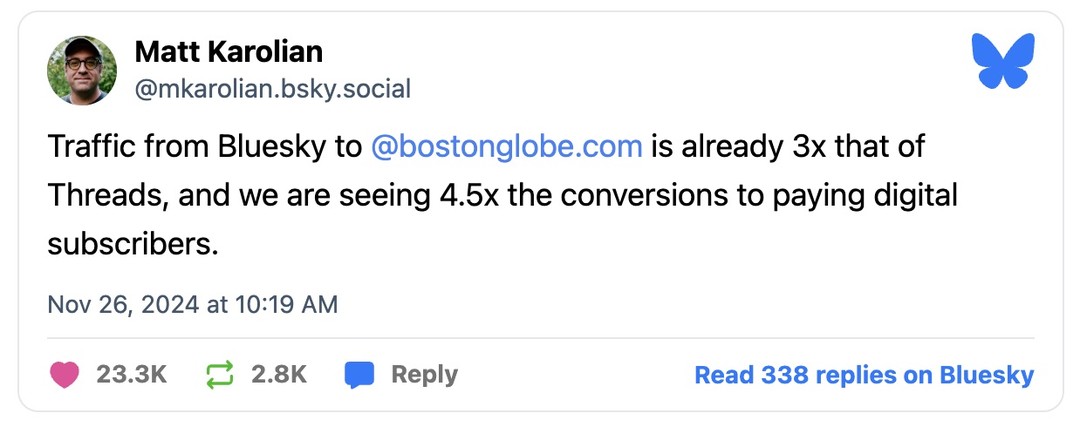It’s a crazy time for news publishers trying to share their stories on social media. Just a few years ago, Twitter and Facebook were the two big platforms to reach a huge audience of social media users. But since Elon Musk’s purchase of Twitter and transformation into X, a mass migration of users has fled the platform, and the social media landscape has splintered into pieces. Now in addition to X, there is Meta’s Threads and Twitter spin-off Bluesky. But something interesting is happening with audience engagement on Bluesky.
Among this group of text-based platforms, X is still a juggernaut with 535 million users overall. Both Threads and Bluesky have been adding over a million users per day recently, but Threads’ 275 million users dwarfs Bluesky’s 23 million.
Neglecting news
Meta has stepped back from positioning itself as a source for news, and across Instagram, Facebook and Threads, news content does not get the same algorithmic boost that it used to. Elon Musk this week appeared to confirm that posts on X with links off the platform are deprioritized, which he referred to as “lazy linking”:
Just write a description in the main post and put the link in the reply. This just stops lazy linking.
— Elon Musk (@elonmusk) November 24, 2024
But over on Bluesky, news has no such algorithmic speed bump. Users have been noticing that while Bluesky’s audience is a mere sliver of X and Threads’ user bases, it has been delivering as much engagement as the bigger platforms, and in some cases eclipsing them. “Engagement” refers to how much users interact with any given piece of content, measured in likes, replies or reposting a story.
At least anecdotally, medium-sized to large publishers have begun to report that internal data gives Bluesky a pretty remarkable edge.
@mkarolian.bsky.social
Let’s take a look at how engagement varies from platform to platform for some big news stories published by The New York Times, CNN and The Wall Street Journal. But first, let’s look at the audience size for these publishers on each platform.
Engagement per million users
We picked three recent stories that were around a day old at least, across a few different topics, that were published by the official accounts for The New York Times, The Wall Street Journal and CNN on X, Threads and Bluesky.
To control for the vastly different size of the platforms, we assigned each story an “engagement per million users” score:
(Likes + re-posts + replies) / (total number of users on platform / 1 million) = engagement per million users.
Of course, there are some limitations to this analysis. This experiment doesn’t control for the many, many variables that affect user engagement numbers. For example, it doesn’t account for the weight of each type of engagement (a “like” is easier than a reply for example). Also, this does not account for the different political vibe of each platform, which could lead to certain stories getting much different reactions on different platforms. But when you plot out these scores, you do see much more engagement for the same stories on Bluesky.
Getting a consistent measure of active users on each platform is tricky. Using monthly active users (MAUs) as the devisor in this equation would be a more accurate way to measure this engagement rate, but we don’t have hard numbers for each platform. X says that it has 535 million “Global monetizable monthly active users”, but Musk recently said that there are about 300 million daily active users. So even if that is accurate, X numbers might look close to Threads, as Meta says they have 275 million monthly active users.
Given that these are still generally similar orders of magnitude to overall user numbers, plugging in those estimates doesn’t meaningfully change what the chart shows: Bluesky sure looks hot right now.
Another possible explanation is that because Bluesky is new, it is probably just full of more fresh, engaged users. After all, X is carrying 18 years worth of users, and as a private company it doesn’t have to share as much detail about its users with regulators and investors.
News publishers are eager to find platforms that can get their stories in front of readers without fighting opaque algorithmic rules, so this increased engagement may lure more publishers to the platform.
With an eye on Bluesky’s skyrocketing growth, and the other platforms may be taking notice. Just last week, Meta rolled out a flurry of features like allowing a non-algorithmic “followers” feed to be the default, and rolling out “starter packs”, which have been hugely popular on Bluesky.
This post was originally published on this site be sure to check out more of their content








